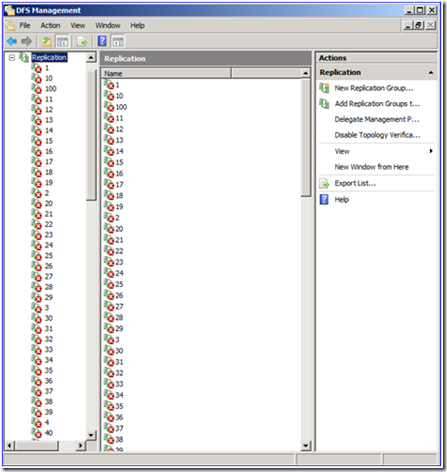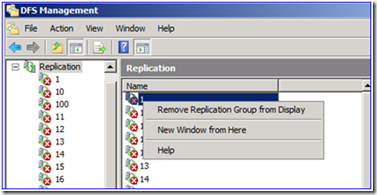Ghosts in the DFS Management Machine
Ned here again. Today’s post is a quick technique I use to show how to slap the DFS Management snap-in around when it acts foolishly. Hopefully you find it helpful someday.
Here’s the situation
- There are multiple administrators at your company managing DFSR or DFSN.
- Everyone (naturally) uses the DFS Management snap-in from their own workstation, or from various servers.
- Someone deletes a large number of DFSR Replication Groups or DFSN roots – maybe they are recreating a new topology, working in the lab, or whatever.
So let’s say I had this:
Then I start up DFSMGMT.MSC and now I have this:
No big deal, I’ll just click the refresh button. Wait, where’s the refresh button? No matter, I’ll just press F5, that always refreshes stuff… crud, still there. Ok, I’ll just press CTRL+A and select everything… you have got to be kidding me! Are you saying that I have to right-click every single object node and choose ‘Remove Replication Group from Display’?
Not anymore.
A little background
The DFS UI development team writes the DFS Management snap-in for optimal performance. They achieve performance gains by caching new expensive data from LDAP. This optimization prevents the management tool from over utilizing the network with unnecessary queries. The snap-in recognizes when information is new and remembers it. However, the behavior changes when we delete information. The concept of deleting setting in masses in large environments was overlooked.
Never mind that, fix it!
So where’s this cache? Right here:
%appdata%\Microsoft\MMC
Open the path listed above. This path expands to a folder within your profile, like this:
C:\Users\nedpyle\AppData\Roaming\Microsoft\MMC
You'll see a file named ‘dfsmgmt’ without a file extension.
Close the DFS Management snap. Then delete or rename the dfsmgmt file. Start the snap-in. Voila. All the extraneous deleted goo, which was removed by someone else, is now gone. You can use the same file and technique to remove large numbers of DFS Roots. We’re looking into getting a darned refresh button added too. ;-)
I told you it was quick.
- Ned ‘Hammer Approach’ Pyle
Comments
Anonymous
June 12, 2009
I had this problem when I was toying with DFSN/DFSR last year...glad to see this technique is documented here now too :)Anonymous
June 13, 2009
hello, we notice that when we want to add namespaces with dfsn, only the pdce is used to enumerates dfs namespaces. If the pdce is not online, the enumeration stops with error "domain not found". Is it possible that the DFS Management snap-in uses all DCs but not exclusively the pdce for dfsn enumeration ? thxAnonymous
June 15, 2009
244 Microsoft Team blogs searched, 110 blogs have new articles. 271 new articles found searching fromAnonymous
June 15, 2009
offtopic: I've used those cache files for WSUS snapin to get the identical view on both my laptop and desktop machine. So copying them across machines to supply an initial view is a possibility.Anonymous
June 15, 2009
I had started posting some of the interesting Directory Services-related posts from other blogs, butAnonymous
June 15, 2009
The comment has been removedAnonymous
July 06, 2009
This is very good news was well informed that the followers of the issue I am. Thank you ...Anonymous
July 21, 2009
Introducing such a topic you'd like to congratulate you've let us know. Have good workAnonymous
November 30, 2009
This and similar information-sharing my vocabulary expanded again. Thank you for your writing ...Anonymous
March 05, 2010
I had this problem when I was toying with DFSN/DFSR


